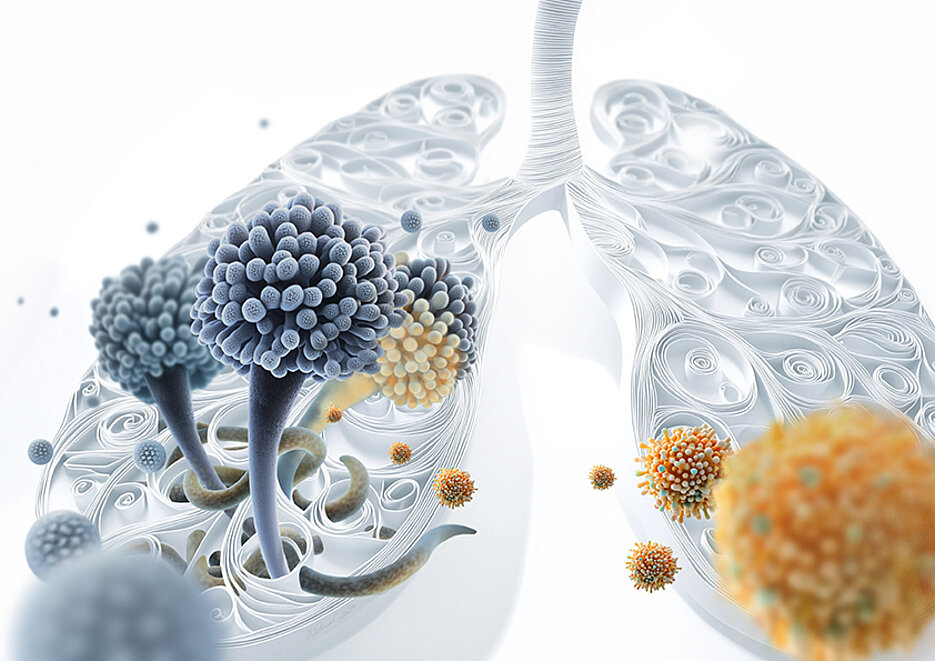Würzburg researchers present a new strategy against the life-threatening fungus Aspergillus fumigatus. They combine RNA molecules and an antifungal agent in nanoparticles.

Fungal infections are on the rise globally. According to a study by the Manchester Fungal Infection Group, in 2022, approximately 6.5 million people were infected by a pathogenic fungus, and about 3.8 million died as a result - nearly twice as many as in 2012.
Even with medications, known as antifungals, the mortality rate for invasive infections caused by the mold Aspergillus fumigatus is as high as 85%. As resistant fungal strains increase, treatment becomes more difficult, and new therapies are urgently needed. A team from the University Medicine Würzburg, Germany, now show a promising strategy against fungal infections in the journal Nanoscale.
RNA and Antifungal Agents Packaged in Nanoparticles
To attack the mold Aspergillus fumigatus, the researchers combined an RNA approach with an optimised delivery technology from nanomedicine.
Small RNA molecules such as small interfering RNA (siRNA) are able to specifically switch off certain genes. The Würzburg researchers packaged such RNAs together with the antifungal agent amphotericin B in tiny fat particles. This made it possible to switch off vital genes of the fungus and inhibit its growth - a groundbreaking step towards new therapies against pathogenic fungi.
"While siRNA therapies have already been used for genetic diseases, our work is the first successful application of this technology against a human pathogenic fungus in infection models," explains first author Dr. Yidong Yu from the Center for Experimental Molecular Medicine and the Department of Medicine II of the University Hospital Würzburg (UKW).
Technological Breakthrough in Fungal Control
One of the biggest challenges was packaging the siRNA in a way that it could penetrate the thick cell wall of the fungus. "The trick was to combine anionic liposomes with small amounts of the antifungal drug Amphotericin B," reports co-first author Theresa Vogel.
Anionic liposomes are tiny fat vesicles with a negative charge. Amphotericin is a proven antifungal medication that makes the fungal cell walls more permeable, allowing the siRNA to penetrate the fungal cells and specifically inhibit three crucial genes necessary for fungal growth.
The concept was developed by the researchers in close collaboration with Dr. Krystyna Albrecht and Professor Jürgen Groll from the Institute of Functional Materials in Medicine and Dentistry at UKW, who tested various nanoparticle strategies until the breakthrough was achieved.
New Path: Insect Larvae Instead of Mice
Another innovative aspect of the study is the use of insect larvae instead of mice as an infection model to reduce animal testing in mammals. "This work shows how interdisciplinary collaboration enables innovative approaches in nanomedicine," emphasizes co-senior author Krystyna Albrecht.
"The results of our study show that this method significantly reduces fungal growth in infection models and as a proof-of-concept demonstrates the effectiveness of siRNA as a promising tool against fungal infections in humans," summarizes senior author Professor Andreas Beilhack from the Department of Medicine II of UKW. "The study is particularly significant because infections with Aspergillus fumigatus are increasing globally, and resistance to common antifungals is becoming more common. The siRNA strategy could not only be used against Aspergillus fumigatus but also against other dangerous fungal pathogens."
Funding
The study was funded by the German Research Foundation (DFG) within the research consortia "FungiNet" (SFB/TRR 124) and "Biofabrication" (SFB/TRR 255).
Publication
Yu Y, Vogel T, Hirsch S, Groll J, Albrecht K, Beilhack A. Enhanced antifungal activity of siRNA-loaded anionic liposomes against the human pathogenic fungus Aspergillus fumigatus. Nanoscale. 24 March 2025;17(12):7002-7007. DOI: 10.1039/d4nr03225j. PMID: 39508295






